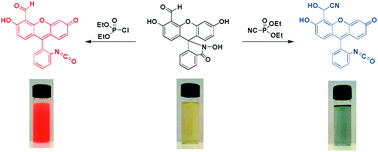D. Raghavender Goud, Deepak Pardasani, Vijay Tak and Devendra Kumar Dubey
RSC Adv., 2014,4, 24645-24648
DOI:
10.1039/C4RA02742F,
Communication
A new tabun specific visual detection protocol is reported. The chemodosimeter fluorescein-hydroxamate aldehyde undergoes tandem nucleophilic substitution followed by cyanohydrin reaction with DCNP and shows a specific spectroscopic behaviour. The probe molecule clearly distinguishes tabun mimic DCNP over other nerve agent simulants as well as strong electrophiles.
